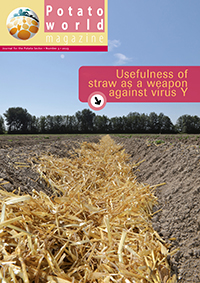Already a subscriber? Activate your premium account

Potatoworld Magazine

Potato and its derivatives increasingly become globally traded products. When I visit Chile and ask at a restaurant when eating French fries where they come from, they usually are from Belgian and Netherlands companies. Once in a German restaurant, of course, they came from Germany. The frozen French fries industry in Chile is insignificant and apparently it is cheaper to grow potatoes in Northwestern Europe, then fry and freeze them here, transport them through the Panama Canal all the way South, rather than producing them in the southern cone of South America. Similarly the South African frozen potato product market suffers from competition from imports from Egypt and Argentina. America exports to countries on the West side of the Pacific and even European products compete with local ones in Australia. Potato starch and flour is also traded globally whereas its production concentrates in northern Europe.
Food companies increasingly want to quantify the environmental footprints such as the use efficiency of the of land, water, CO2 and the risks of eutrophication and risks of contamination of the environment with pesticides. They use principles such as biodiversity and water should not be threatened and criteria such as the area and number of species in bio-diverse regions should not diminish and the amount of fresh water should remain the same as well as its quality. Subsequently indicators are identified and quantified such as how much land is dedicated to potato, how many cubic meter of ground water is used per ton of potatoes or how many kg of CO2 does it cost to produce one ton of potatoes. With trade globalizing there is an increasing need to gain insight in the sustainability hotspots of potato production worldwide.

The potato agricultural systems team at Wageningen University developed a global potato hotspotter. From various sources global maps with grid cells of 10 km x 10 km (10,000 ha) were drawn representing potato relative area, yield (land use efficiency), slopes (risks of erosion, lack of mechanization opportunities), precipitation deficit (risks of depletion of fresh water resources through irrigation), average daily maximum temperature throughout the season (risks of occurrence of pest epidemics and emission of pesticides). Hotspots for erosion are the slopes of the mountains in the Andes, African Rift, Southern China and volcanic areas in southern China, and the archipelagos in South East Asia. Fresh water availability may become a threat in the East of North America, northern India and China. Risks of insects are in continental hot summer climates and short spring crops with high temperatures towards harvest and late blight is a threat in all humid areas such as maritime Europe, Equatorial tropical highlands and the humid western Pacific Ring. The examples discussed in a first draft of a scientific paper can be elaborated for more soil and weather related factors such as acidity, salinity, heat waves and torrential rains. Data from various sources are also processed into derivative maps showing which areas have the highest degree of nitrogen leaching, the highest threat of late blight caused by Phytophtora infestans, the highest CO2 costs and the closest proximity to fragile important ecosystems to name a few. When taking global trends into consideration such as the need for more food and climate change the maps can be adjusted and conclusions drawn more precisely.
Sustainable long-term and long-range sourcing are deliberated as well as repercussions of trends such as globalization and climate change; the latter being relative favourable for the root and tuber crop potato. An example of a hotspot map is shown here. It shows a map of the world where potato is grown: only in the coloured part. Red shows where it hardly rains during the growing season so crops need irrigation costing water and energy. In the green parts rainfall exceeds evapo-transpiration. When sourcing potatoes various indicator values of a production area are considered and such hotspot maps yield crucial information at a glance. ●
Anton Haverkort
anton.haverkort@wur.nl
Events
©2015 - 2024 Potatoworld | Webdesign and realisation COMMPRO